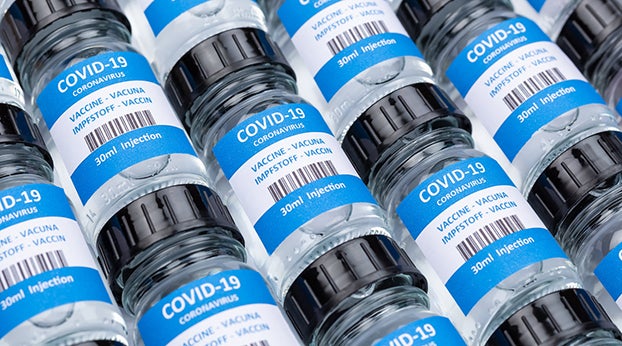Reasons for COVID-19 vaccine hesitancy are many in Kentucky
Published 6:52 am Tuesday, May 4, 2021
|
Getting your Trinity Audio player ready...
|
By Melissa Patrick
Kentucky Health News
In a society that gives out trophies for participation, it’s only natural that the U.S. is celebrating that about a third of its population is fully vaccinated against the coronavirus and 43% have received at least one dose of a vaccine.
But hold those trophies, public health officials might say, because we have a way to go before we reach herd immunity that will offer a level of protection for those who can’t or won’t get a vaccine — and to keep the virus from spreading and mutating, perhaps into more contagious variants.
Vince Venditto, assistant professor in the University of Kentucky College of Pharmacy, told Kentucky Health News he likes to call herd immunity “community immunity” because that better describes what that term actually means and doesn’t invoke an image of cattle.
Herd immunity occurs when a certain percentage of a population is protected against a disease, either through vaccination or infection, providing significant protection for people who are either unwilling or unable to get vaccinated. Health experts aren’t sure, but say a vaccination rate of 75% to 80% is needed to reach herd immunity for the coronavirus.
So, right now the U.S. is not even halfway to herd immunity, and Kentucky’s even farther from it, with only 29% of the state’s population fully vaccinated and 39% having received at least one dose of a vaccine.
Venditto stressed that getting vaccinated is not only about protecting yourself from the virus, but also about protecting the community.
“We need to have a high enough level in our community because there are people in our community that cannot be vaccinated,” he said. “There are medical reasons why they cannot be vaccinated, and so we need to make sure that we’re getting vaccinated to protect the rest of our community.”
Whether the nation or Kentucky is able to meet that goal remains uncertain, since vaccination rates are dropping, the percentage of people not returning for a second shot has gone up, and a persistent 13% of people say in polls that they won’t get vaccinated, no matter what.
Even so, the goal remains the same: to get at least 75% of the population vaccinated to slow the spread of the virus, to slow the spread of the more contagious variants, to decrease hospitalizations and deaths, and to get on with life as we used to know it.
The Kaiser Family Foundation Covid-19 Vaccine Monitor found in March that Republicans, white evangelicals, and people in rural areas were most likely to say they would “definitely not” get the vaccine, but the poll report cautioned that “no group is monolithic in their vaccine attitudes.”
What that boils down to is that there can’t be a one-size-fits-all approach to get the 17% of people who said in the Kaiser foundation’s poll that they would “wait and see” before getting vaccinated. Venditto and the foundation say it’s important that this group hears messages from trusted sources.
“If somebody doesn’t trust the information that is available on what I believe are very trusted sources, I don’t know that you can convince them without sitting down and connecting with them on a personal level,” Venditto said. “I think the challenge that we face as a society is getting enough of those people, leaders in the community, to actually sit down and serve in that capacity.”
That point came to life in an April 30 New York Times article, titled “Faith, Freedom, Fear: Rural America’s Covid Vaccine Skeptics.” It tells a story about the challenges vaccine proponents in East Tennessee have in convincing their largely white, Republican, Christian neighbors to get vaccinated.
Reporter Jan Hoffman sums it up: “A week here in Greene County reveals a more nuanced, layered hesitancy than surveys suggest. People say that politics isn’t the leading driver of their vaccine attitudes. The most common reason for their apprehension is fear — that the vaccine was developed in haste, that long-term side effects are unknown. Their decisions are also entangled in a web of views about bodily autonomy, science, and authority, plus a powerful regional, somewhat romanticized self-image: We don’t like outsiders messing in our business.”
She describes the “near-joyous fatalism” among the religious who believe getting the virus, or not, is in God’s hands, and if they get it and die, they are bound for Heaven. She goes on to write about many who have gotten the vaccine but don’t tell anyone — let alone encourage others to get one too.
But Hoffman also reports that “resistance is not firm” and there is a hunger for information from trusted people, a need for paid time off to recover from any side effects, and a desire to get the shot from their own doctor.
The Biden administration is offering tax credits to employers for paid time off, and Kentucky and some other states are slowly moving away from mass vaccination and scattering vaccine supplies among local providers.
KFF’s polling found, much like Hoffman’s reporting, that the No. 1 reason people gave for their hesitancy were concerns about potential side effects, including missing work because of them. Other concerns reflected a lack of easy access to the vaccine, often related to transportation or the desire to get it from a trusted provider. Others said they had a lack of accurate information.






